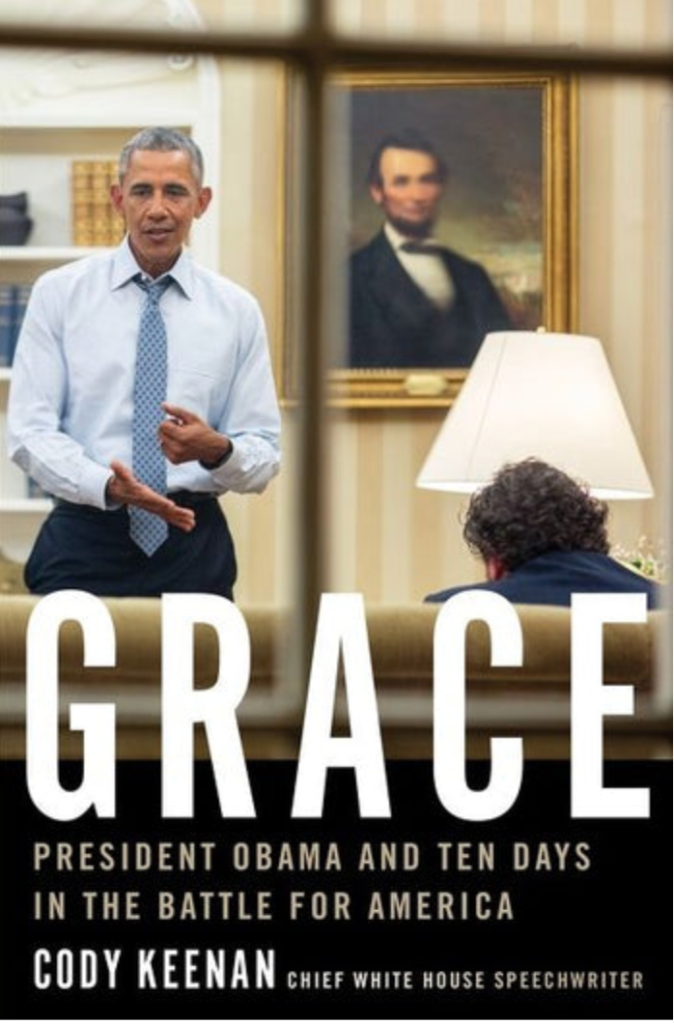Is This Book the New ‘West Wing’?
October 26, 2022
Former Obama speechwriter Cody Keenan's new memoir, "Grace: President Obama and Ten Days in the Battle for America" might appeal to the same kinds of young people who once fell in love with Sam Seaborn.
On a road trip with my wife last weekend, I listened to former President Obama Chief Speechwriter Cody Keenan’s new memoir, Grace: President Obama and Ten Days in the Battle for America.
I had to, I told my wife: This is the first major speechwriting memoir to come out of a White House since Bush White House speechwriter Matt Latimer’s 2009 book, Speech-less: Tales of a White House Survivor, a humorous account that Goodreads described this way: “More like ‘The Office’ than ‘The West Wing,’ the nation’s most storied office building is a place where the staffers who run the country are in way over their heads, and almost everything the public has been told about the major players—Bush, Cheney, Rice, Rumsfeld, Rove—is wrong.”

Grace is more like “The West Wing.” And “The West Wing” means a great deal to professional speechwriters, many of whom fell love with speechwriter Sam Seaborn on “The West Wing,” almost a generation ago. I run into those folks at our conferences all the time. They are in their forties now, and deep into speechwriting careers that look look about as much like Seaborn’s as they themselves look like Rob Lowe. Still, they like their work well enough most days and think of theirs as an honorable, if frustratingly incremental, profession. Ask them what inspired them to become speechwriters, they cheerfully, say, “West Wing”!
Keenan’s book portrays the Obama White House as what it was: a real West Wing staffed by fans of “The West Wing.” Smart, tireless, simultaneously ironic and earnest young people, all pulling in one direction in an administration determined to bend America’s moral arc toward justice—and in service to a president they idolized totally.
Though it’s surely scrubbed of the kinds of stories that beery speechwriters share with one another under the inevitably invoked “cone of silence,” I believe that Keenan and company really did work in a kind of No Drama Obama version of Camelot. And they knew it at the time.
Without palace intrigue, where’s the suspense? Over 10 days in June 2015, while working with his staff to juggle multiple drafts of various versions of important speeches about two profoundly important Supreme Court rulings about to be handed down—one on gay marriage and the other on the fate of Obamacare—Keenan is suddenly stuck with the assignment of writing a eulogy for the first Black president to deliver to a Black church congregation in Charleston, South Carolina, in meaningful memory of the Black Reverend Clementa Pinkney, killed by a white supremacist in mass shooting. And the 35-year-old native of north-side Chicago is understandably wondering whether he’s culturally and spiritually up to the job.
The days are counting down, the president is waiting for a draft, and in the hurly-burly of a particularly busy week in and around Keenan’s windowless “speech cave,” the writing’s not getting done.
The story comes complete with a love interest—throughout the book, Keenan cautiously courts White House fact-checker Kristen Bartoloni, and their growing romance becomes part of the central plot, as she gives Keenan pep talks of varying tones as the deadline looms.
There’s a White House all-nighter involving coffee and cigarettes and ending in the guilty consumption of a Domino’s pizza. There’s editing on Air Force One. There are beers here and bourbons there.
And along the way, there’s discussion about which types of music to listen to when writing which kinds of speeches in which kinds of moods. Drafts are reviewed, feedback taken, edits made, scripts printed out and more revisions done. There are walk-and-talks, there are stairs taken two at a time and there are lots—and lots—of collegial fist bumps.
I grumbled to my snoozing wife over some of these scenes, I have to admit. And I have to ask myself why.
Partly, because I admired the Obama White House so much and am (still) grieving its loss. To revisit that sane and decent place knowing what came immediately after, was like spending a few hours enjoying the wonderful views and modern comforts and sparkling company on the Hindenburg. (A feeling I’m used to, having also listened to the first volume of Obama’s White House memoir, over some 30 hours.)
Also: The overwhelming most of speechwriting work—at corporations, nonprofits, universities and even in politics—does not rise, nor have even the potential to rise, to the rhetorical heights that President Obama and his speechwriters were striving for on some of these speeches. And most of the work most speechwriters do, they do without the support of fist-bumping buddies—but all alone, as the only scribe on the communication staff. On their workaday behalf, this book feels like a little bit of a tease (as most White House memoirs do).
Next: Let’s face it, stories about editing are hard to make compelling. Who would sit still to read William Faulkner telling exactly how he went about rewriting the middle 150 pages of Light in August? Only the most eager student of literature, I’d say. Thus, the really substantive parts of this book, well rendered as they were, sometimes made me wish I could fast forward to Keenan’s day-ending bourbon.
I stopped grumbling at the conclusion, which Keenan addressed to what I suddenly understood was his primary audience for this book: young writers. Which is natural, as Keenan now teaches speechwriting at Northwestern University. And which is right, as young writers are the ones who will be called on to articulate the future of politics.
And young writers require the romance Keenan infuses into this book, need to believe in the rhetorical blue sky he paints and must understand in some detail the iterative drafting process and how collaboration really works between a speaker and a writer.
Cody Keenan’s book does all that perfectly, and I hope it finds its impressionable audience early and hits them hard and makes them believe they could work in a real-life West Wing like this, for a president they believe in, this much.
It all finally got to my wife, anyway: She was playing the Charleston speech on her phone, and I caught her wiping a tear away during “Amazing Grace.”



